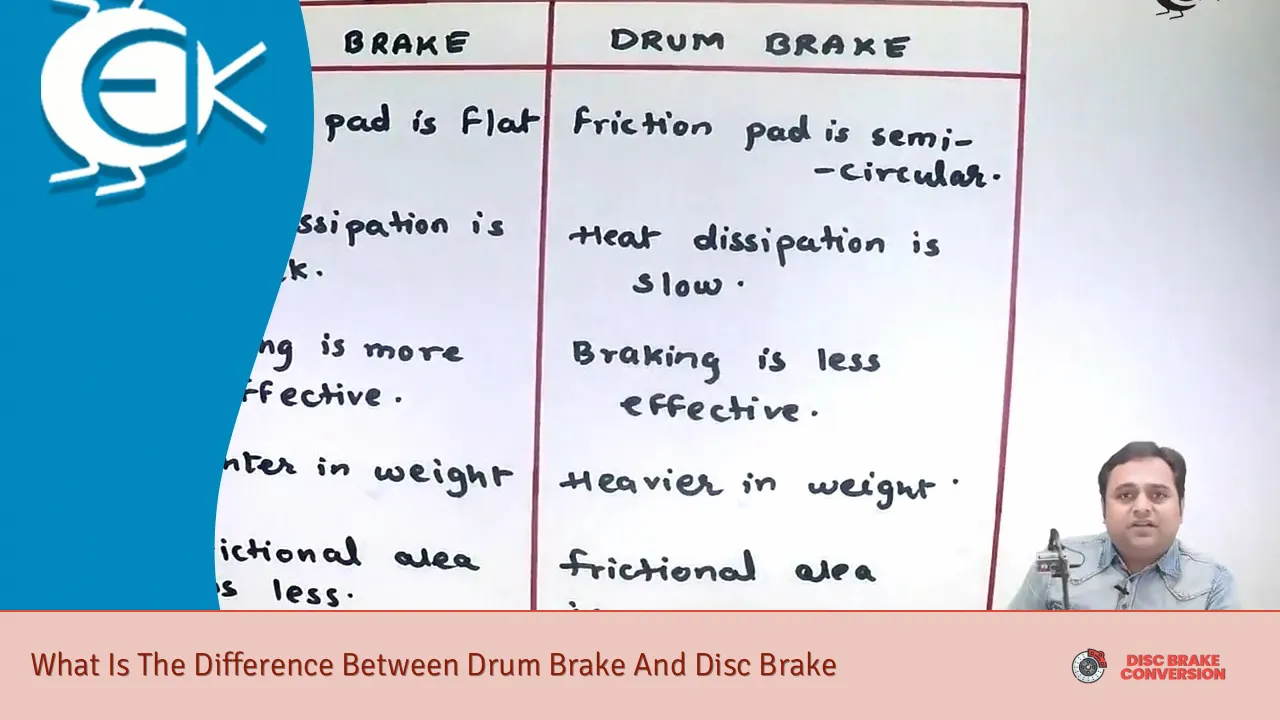Have you ever wondered what sets drum brakes and disc brakes apart? Whether you’re a car enthusiast or simply curious about how your vehicle’s braking system works, understanding the dissimilarities between these two types of brakes can be fascinating. So, let’s dive into the details and explore the difference between drum brakes and disc brakes.
Picture a drum brake as a round-shaped device resembling a drum, located inside each wheel. When you press the brake pedal, hydraulic pressure causes two curved brake shoes to expand outward, applying friction against the inner surface of the drum, resulting in deceleration. This design is commonly found in older vehicles and some modern rear-wheel-drive cars.
In contrast, disc brakes are more like sophisticated clamps. Imagine a flat, shiny disc attached to the wheel hub. When you apply the brakes, hydraulic pressure forces brake pads to squeeze onto both sides of the spinning disc. This creates friction that slows down the rotation of the wheel. Disc brakes are often used in front-wheel-drive vehicles and high-performance cars for their superior stopping power.
Now, let’s compare these braking systems in terms of performance. Drum brakes, although reliable, have certain limitations. Due to their enclosed design, they tend to heat up quickly during prolonged heavy braking, leading to reduced effectiveness known as brake fade. Additionally, drum brakes are generally harder to cool down, making them less suitable for demanding driving conditions.

On the other hand, disc brakes excel in dissipating heat efficiently, thanks to their open design. They offer better heat dissipation, preventing brake fade and ensuring consistent performance even under intense braking situations. Moreover, disc brakes provide enhanced modulation, allowing drivers to achieve precise control over braking force, resulting in a safer driving experience.
When it comes to maintenance and repairs, disc brakes have an edge. Their design allows for easier inspection and replacement of brake pads, resulting in lower labor costs. Drum brakes, being more complex, require additional steps to access their components, making them relatively more time-consuming and expensive to service.

While both drum brakes and disc brakes serve the same purpose of slowing down or stopping a vehicle, they differ significantly in design, performance, and maintenance. Disc brakes offer superior heat dissipation, better modulation, and easier maintenance, making them a popular choice for many modern vehicles. However, drum brakes still have their place in certain applications, particularly in older car models. Understanding these distinctions empowers you to make informed decisions about your vehicle’s braking system, ensuring safety and optimal performance on the road.
Revolutionizing Braking Technology: Unveiling the Battle Between Drum Brake and Disc Brake
Are you ready to dive into the fascinating world of braking technology? Today, we are going to explore the heated battle between two prominent contenders: the drum brake and the disc brake. These two braking systems have revolutionized the automotive industry, each with its own set of advantages and disadvantages. So, let’s buckle up and embark on this exhilarating journey.
First, let’s meet the drum brake, a veteran in the braking arena. Just like a snare drum, it operates on the principle of friction. When you press the brake pedal, hydraulic force activates the brake shoes, causing them to press against the brake drum. This action generates friction, which slows down the rotation of the wheel and brings your vehicle to a halt. The drum brake has been a trusted companion for many years, providing reliable stopping power and durability.
On the other hand, emerging as a fierce competitor, we have the disc brake. Picture a spinning vinyl record—the disc brake functions similarly. Instead of brake shoes and drums, it utilizes brake pads and rotors. When you apply the brakes, hydraulic pressure causes the brake pads to clamp onto the rotating rotor, creating friction that slows down the wheel. The major advantage of disc brakes lies in their superior heat dissipation capabilities, ensuring consistent performance even under extreme conditions.
Now, let’s compare these two contenders head-to-head. In terms of stopping power, disc brakes take the lead. They offer more efficient and responsive braking, especially in emergency situations. Additionally, they have a remarkable ability to dissipate heat quickly, preventing brake fade and ensuring optimal braking performance.
However, drum brakes still have their merits. They are less prone to contamination from debris and water, making them ideal for off-road or wet conditions. Moreover, drum brakes are often more cost-effective compared to disc brakes, making them a popular choice for budget-conscious consumers.
The battle between drum brakes and disc brakes continues to captivate automotive enthusiasts worldwide. While disc brakes offer enhanced performance and heat dissipation, drum brakes remain a reliable and cost-effective option. The choice between the two ultimately depends on various factors such as driving conditions, vehicle type, and personal preference. So, next time you hit the brakes, remember the incredible technology at work behind that simple pedal push.
Breaking Down the Basics: Exploring the Key Distinctions Between Drum and Disc Brakes
Are you ready to dive into an exhilarating journey where we explore the fascinating world of automotive braking systems? Today, we’ll be breaking down the basics and delving into the key distinctions between drum brakes and disc brakes. Buckle up and get ready for an informative joyride!
First things first, let’s understand the fundamental disparity between these two braking systems. Drum brakes, as the name suggests, consist of a round drum that rotates with the wheel. Inside this drum, brake shoes are pushed outward when you apply the brakes, creating friction against the drum and ultimately slowing down the vehicle. On the other hand, disc brakes utilize a flat disc called a rotor that spins with the wheel. When you press the brake pedal, calipers squeeze brake pads onto the rotor, generating the necessary friction to halt your car.
While both drum and disc brakes serve the vital purpose of stopping your vehicle, they possess distinctive characteristics. In terms of performance, disc brakes have the upper hand. They offer superior stopping power, especially in situations requiring sudden and forceful braking. Disc brakes also dissipate heat more efficiently, minimizing the risk of brake fade during prolonged or aggressive braking sessions.
On the flip side, drum brakes boast a simpler design and are generally more cost-effective. They are commonly found in the rear wheels of many vehicles and tend to require less maintenance. However, drum brakes are not as effective at dissipating heat, which can result in diminished braking performance over extended use.
Another significant distinction lies in the ease of inspection and replacement. With drum brakes, disassembling the entire system is necessary to inspect or replace components. This process can be time-consuming and requires a higher level of expertise. Conversely, disc brakes provide easy access to the brake pads and rotors, simplifying inspection and replacement procedures.
To summarize, while drum brakes offer affordability and simplicity, disc brakes take the lead in performance and heat dissipation. Understanding these key distinctions will help you make informed decisions when it comes to maintaining, upgrading, or choosing the right braking system for your vehicle.
Now that we’ve explored the basics of drum and disc brakes, buckle up and join us in our next installment as we delve deeper into the intricate world of automotive braking systems. Stay tuned for more exciting insights and discoveries!
From Traditional to Cutting-Edge: Understanding the Evolution of Drum and Disc Braking Systems
From traditional to cutting-edge, the evolution of drum and disc braking systems has revolutionized the automotive industry. These crucial components play a vital role in ensuring the safety and control of vehicles, allowing drivers to navigate roads with confidence. Let’s delve into the details of these braking systems and explore their fascinating journey.
Drum brakes, the pioneers of the braking world, have been around for decades. They consist of a hollow drum attached to the wheel, housing brake shoes that press against the inner surface of the drum when the brakes are applied. This friction slows down the vehicle. While effective, drum brakes have certain limitations. They are prone to overheating due to inadequate airflow, which can result in reduced braking performance. Moreover, their design makes them susceptible to fade during prolonged or repeated usage.
Enter disc brakes, the game-changer in the braking realm. Disc brakes feature a flat rotor attached to the wheel, and calipers that clamp brake pads onto the rotor, generating the necessary friction to halt the vehicle. This innovative design provides several advantages over drum brakes. First and foremost, disc brakes dissipate heat more efficiently, thanks to their exposed design, reducing the risk of fade and ensuring consistent performance. Additionally, they offer improved stopping power, allowing for shorter braking distances and enhanced overall safety.
The transition from drum to disc brakes was not an overnight phenomenon. It involved extensive research, development, and technological advancements. Engineers and manufacturers recognized the need for superior braking systems, especially as vehicles became faster and more powerful. The demand for increased safety standards propelled the rapid adoption of disc brakes in various types of vehicles.
Modern braking systems continue to evolve, incorporating advanced technologies to enhance performance and efficiency. Anti-lock braking systems (ABS), electronic brake force distribution (EBD), and electronic stability control (ESC) are just a few examples of the cutting-edge features integrated into today’s braking systems. These innovations work in harmony, optimizing braking performance, reducing the risk of skidding, and ensuring maximum control in diverse driving conditions.
Decoding Brake Performance: How Drum and Disc Brakes Differ in Stopping Power
When it comes to brake performance, understanding the differences between drum and disc brakes is essential. These two braking systems have distinct characteristics that impact their stopping power. In this article, we will decode the nuances of drum and disc brakes and explore what sets them apart.

Let’s start with drum brakes. Picture a cylindrical drum housing brake shoes inside. When you press the brake pedal, hydraulic pressure forces the shoes outward, causing them to contact the inner surface of the drum. This friction slows down the rotation of the wheels, bringing your vehicle to a halt. Drum brakes are known for their durability and ability to withstand harsh conditions. They are commonly found in the rear wheels of older vehicles and some entry-level models.
On the other hand, disc brakes employ a different mechanism. Instead of a drum, a disc or rotor is attached to the wheel hub. When you apply the brakes, calipers squeeze brake pads against the spinning rotor, generating friction and reducing rotational speed. Disc brakes offer superior performance, especially in terms of cooling and heat dissipation. They provide consistent stopping power even under demanding circumstances, making them a popular choice in high-performance vehicles.
In terms of stopping power, disc brakes have the edge over drum brakes. The design of disc brakes allows for more efficient heat dissipation, preventing brake fade and maintaining consistent performance. Additionally, they provide better modulation and feel, allowing drivers to apply the brakes more precisely.
However, drum brakes still have their merits. They tend to be less expensive than disc brakes, making them a cost-effective option for certain applications. Drum brakes are also self-energizing, meaning they can generate additional force during braking, which can be advantageous in certain scenarios.
Both drum and disc brakes serve the crucial role of stopping your vehicle, but they differ in terms of design and performance. While drum brakes are durable and cost-effective, disc brakes offer superior stopping power and thermal management. Understanding these distinctions can help you make informed decisions about your vehicle’s braking system, ensuring optimal performance and safety.

